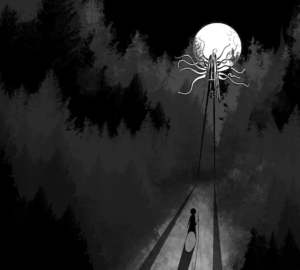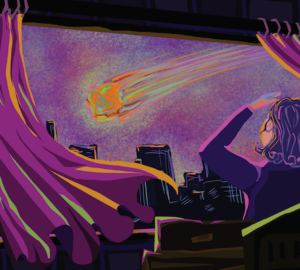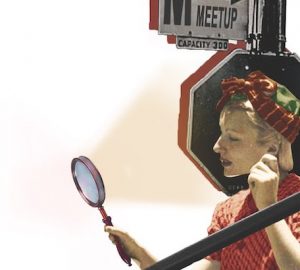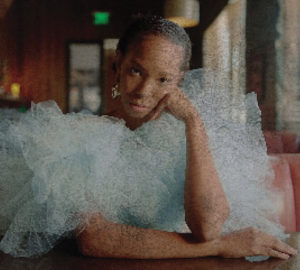The Plaza on Ponce
Nostalgia shows on the big screen at Atlanta's oldest continually operated movie theater
WRITTEN BY MIKAEL TRENCH
PHOTO ILLUSTRATION BY EMMA DAKIN

For some of us, our most nostalgic memories happened at the movies. Maybe it’s where we made our fondest family moments or had a first date or first kiss, but more than anything, the movies allowed us to experience a journey to worlds we could never have imagined. It’s safe to say that cinemas are a mainstay of our culture and has a great influence on who we are.
Atlanta, as a movie mecca, is no exception. Without a doubt, anyone looking for a nostalgic, cinematic experience will find it at the Plaza Theatre. According to History Atlanta, the iconic theater opened its doors on Dec. 23, 1939, making it Atlanta’s longest-running, continuously operating movie theater. The establishment was originally art deco in style, with 1,000 seats, an orchestra pit and balcony levels. Following its initial success, the theater continued to entertain audiences through the 1960s. Several notable classic films played at the theater during this time such as “Around the World in 80 Days” (1956) and “King of Kings” (1961).
However, things began to take a nasty turn in the 1970s when the area around the theater became a hub for drug use and prostitution. Much of the neighborhood and its establishments lost value. The Plaza Theatre was no exception, and during this time it began showing X-rated films and burlesque shows to stay afloat.
Fortunately, the theater would recover as the ’80s rolled in. During the early part of the decade, property owner Robert Griffith enticed business owners to come in to help restore the area, and he got movie theater entrepreneur and enthusiast George Lefont to bring some life back to the Plaza Theatre.
Lefont’s leadership and influence had the most significant impact in the revitalization. Under his guidance, the theater began to focus on independent, foreign and arthouse films throughout the 80s and 90s, giving the theater a more sophisticated appeal.
As the 2000s came around, one of the theater’s most popular attractions, “The Rocky Horror Picture Show” screenings, was born. On Dec. 1, 2000, the fan group Lips Down on Dixie put on their very first showing of the classic story. Valuing inclusiveness, artistry, accuracy, growth, self-love and overall fun, the group continues to give elaborate performances every Friday night at the Plaza.
While “Rocky Horror” definitely helped propel the Plaza into a fun, urbane light, the theater still struggled financially. In 2006, the Plaza was sold to Gayle and Jonathan Rej, a couple dedicated to historical preservation. While keeping the indie and arthouse ambiance set forth by Lefont, the theater began to mix classic films with mainstream releases.
In 2009, to celebrate the theater’s 70th anniversary, the theater presented screenings of some of the most popular films of 1939 including “The Wizard of Oz” and “Mr. Smith Goes to Washington.” A year later, the theater hosted the Atlanta premiere of “Scott Pilgrim vs. the World” with stars Michael Cera, Jason Schwartzman and director Edgar Wright attending the screening. In both 2010 and 2012, Tommy Wiseau made guest appearances at the Plaza to attend the theater’s famed midnight screenings of Wiseau’s 2003 cult classic “The Room,” which have arguably become nearly as popular as the Rocky Horror Picture performances. According to Atlanta Intown, the theater was then sold again, this time as a non-profit to theater enthusiast Michael Furlinger in 2013.
With a reported 500-percent increase in attendance, the theater was sold most recently to Christopher Escobar, executive director of the Atlanta Film Society. According to Curbed Atlanta, Escobar purchased the establishment for $18.1 million in the summer of 2017. As a primary spot for the Atlanta Film Festival, it’s no surprise that Escobar would be next in line to take care of this legendary landmark.
Escobar has made plans to strengthen relationships with the theater and its supporters to encourage more community involvement, according to the Atlanta Journal-Constitution. Such relationships include Lips Down on Dixie, Candace Weslosky. She helped curate and perform in the Cineprov troupe, a group that does live comedic commentary of bad movies, like “Mystery Science Theater 3000” and the Atlanta Film Society. Similarly, the theater hopes to increase involvement with the indie filmmaker community, allowing opportunities for filmmakers to rent out the space.
Through thick and thin, the Plaza has always been here for Atlanta and given us lasting memories in the process. To some locals, ensuring the Plaza and cinemas like it keep going is crucial to keeping Atlanta’s history alive. Second-year film and television student Ivy Buford said that she believes “preserving Atlanta’s history, the good, the bad and the ugly, is important for us to know how far we’ve come and to help us continue to make improvements, so that history doesn’t repeat itself.”
The Plaza Theatre also stands as a testament to the past, as second-year film and television student Helet Van Staden said, “In our modern society, we are taught so often only to look towards the future because the past was bad … but sometimes we need to preserve things just because they survived this long.”
Now with Atlanta being such a major industry for filmmakers and streaming services making for tough competition, it seems that the Plaza and the one-of-a-kind experience it offers is needed more than ever. But as long as there will be people who want to experience movies and share those nostalgic and emotional journeys with the ones they love, the Plaza will be around to offer new memories for everyone.
































